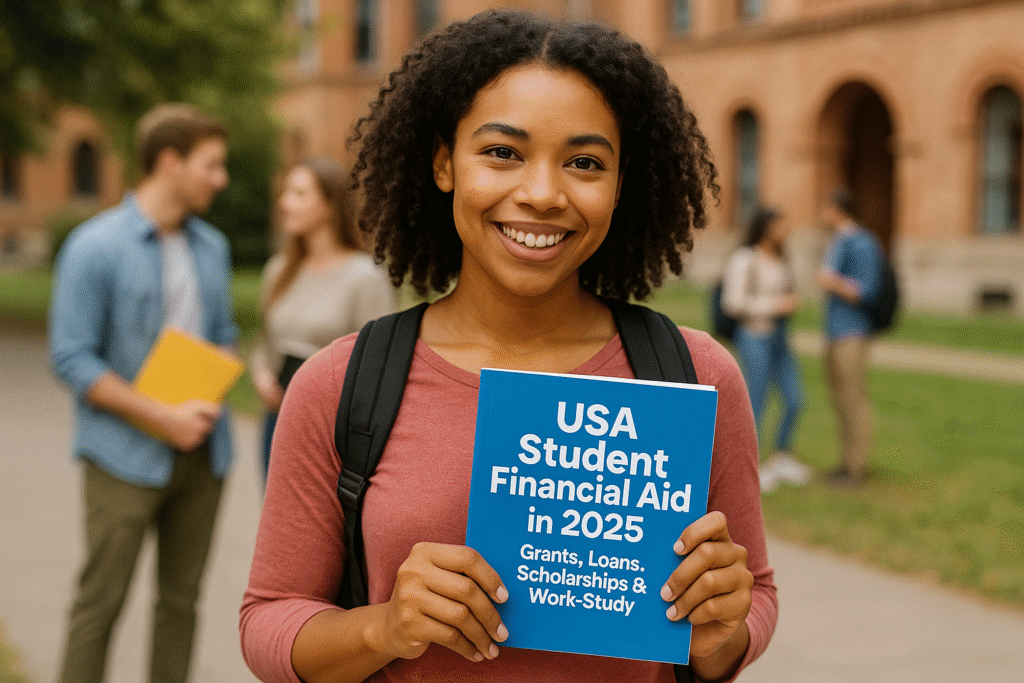USA student financial aid: College or career school costs are real — but so are the options to lower them. This friendly, step-by-step guide explains the main types of student financial aid, how to qualify, where to apply, and how to avoid scams. It’s updated with official program facts so you (or a student you care about) can act quickly and confidently.
Quick snapshot — the four major aid types
- Grants — usually don’t have to be repaid (the Federal Pell Grant is the main example).
- Scholarships — free money from schools, nonprofits, and private groups (often merit- or talent-based).
- Work-Study — part-time jobs (federal program) that let you earn while you learn.
- Loans — borrowed money you must repay; federal loans generally offer the best borrower protections and repayment options.
The doorway to nearly all federal, state, and many institutional aid programs is FAFSA — the Free Application for Federal Student Aid. Fill it out on time every year to be considered.
1 — Start with FAFSA (every year — no exceptions)
Why: FAFSA is how schools and the federal government determine eligibility for Pell Grants, federal loans, work-study, and many state and institutional awards. Deadline dates vary (federal, state, and school deadlines differ), so file as early as possible each award year.
Quick steps:
- Create an FSA ID and log in at the official FAFSA site (studentaid.gov).
- Have Social Security numbers, tax info, and asset info ready.
- List every school you’re considering (they can access your FAFSA data).
- Renew or re-submit the FAFSA each school year.
2 — Grants: free federal aid for eligible students (Pell is the big one)
Federal grants don’t normally need to be repaid unless your circumstances change. The Federal Pell Grant is the largest federal grant program for undergraduates with exceptional financial need — for 2025–26 the maximum Scheduled Award is $7,395. Your actual award depends on your FAFSA Student Aid Index (SAI), enrollment status, and cost of attendance.
Tip: Some students qualify for additional grant programs through their state or school — check those after submitting FAFSA.
3 — Scholarships: search early, apply often
Scholarships are offered by colleges, community groups, employers, foundations, and more. They can be need-based, merit-based, or awarded for a specific talent or background.
How to find them:
- Use your school’s scholarship database and financial aid office.
- Search reputable national scholarship databases and community foundations.
- Ask guidance counselors and employers about lesser-known local awards.
Practical tip: Read application rules carefully. Avoid any service that guarantees awards for a fee — legitimate scholarship searches are free.
4 — Federal Work-Study: earn while you learn
Federal Work-Study provides part-time jobs (on- or off-campus) for students with financial need. To be considered, indicate interest on your FAFSA and accept the award if offered. Work-study pay at least meets federal minimum wage and jobs may relate to your field of study or community service.
Pro tip: If awarded work-study, apply for the campus jobs listed by your school fast — funding is limited and first-come jobs fill quickly.
5 — Federal student loans: know your options & protections
Federal loans include Direct Subsidized and Unsubsidized Loans, PLUS Loans (for parents and graduate students), and consolidation options. Federal loans typically have lower interest rates and flexible repayment plans (income-driven repayment, deferment, forgiveness options) not offered by private lenders. Borrow only what you need and understand repayment terms before you sign.
If you must borrow privately, compare lenders carefully — private loans generally have fewer protections and may require cosigners.

6 — State and institutional aid: don’t skip these
Many states award grants and scholarships based on FAFSA results and residency. Colleges also provide institutional aid (merit or need). After you file the FAFSA, check your state higher-education agency and each school’s financial aid pages for additional opportunities and state-specific deadlines.
7 — Maximize your award package (appeal tactically)
If your financial situation changes (job loss, medical bills, disaster), you can ask your school to re-evaluate your aid — this is called a professional judgment or special circumstances appeal. Provide documentation (termination letter, bills) and ask the financial aid office how to submit an appeal. Many schools will adjust aid when there’s a real change.
8 — Watch for scams — common red flags
Scammers prey on students and families. Avoid any service that:
- Charges to fill out FAFSA or guarantees a scholarship, loan forgiveness, or “exclusive” funding.
- Asks for payment up front to get “free” money.
- Pressures you to act immediately or to share full bank PINs.
Use official government resources (studentaid.gov, usa.gov) and the FTC/CFPB guidance to verify help and report suspicious offers. Never pay someone to file FAFSA — it’s free. (Federal Student Aid, Consumer Advice)
9 — Timing & practical checklist (apply early)
- Before senior year / early: research scholarships and estimate costs with college net-price calculators.
- FAFSA opens each year (check exact date; file ASAP). Schools and states award some funds on a first-come basis.
- After filing FAFSA: compare award letters and total cost (tuition + fees + living) — ask schools to match or improve offers if another school offered better aid.
- Keep records: copies of FAFSA, award letters, scholarship notifications, and correspondence.
Quick printable checklist:
- Create FSA ID (student + parent if dependent).
- Gather SSNs, tax returns, and asset info.
- File FAFSA early and add each school you’re considering.
- Search & apply for scholarships (monthly calendar reminders).
- If offered work-study, apply for campus positions immediately.
10 — Where to learn more & get official help
- Your school’s financial aid office is the best first stop for school-specific questions.
- Use official federal resources for forms and program rules: Federal Student Aid (studentaid.gov) and USA.gov’s student aid pages.
Short FAQ
Q: Do I need to fill out FAFSA even if I think I won’t qualify?
Yes — many schools and states use FAFSA data to award institutional and state aid that isn’t strictly need-based. It’s the gateway for most aid.
Q: What’s the difference between grants and loans?
Grants generally don’t have to be repaid; loans must be repaid with interest. Always prioritize grants and scholarships first.
Q: How much is the Pell Grant in 2025–26?
The maximum Federal Pell Grant Scheduled Award for 2025–26 is $7,395, though actual awards vary by SAI and enrollment.
Disclaimer: This article is for informational purposes only and does not constitute legal, tax, or financial advice. Program rules, award amounts, deadlines, and eligibility can change — always confirm details on official government sites (links below) before taking action. Images used in this article are royalty‑free or licensed for commercial use and are provided here for illustrative purposes.
Helpful official links (clickable)
- Types of student financial aid — USA.gov (overview & links). (USAGov)
https://www.usa.gov/student-aid - Types of financial aid (grants, loans, work-study) — Federal Student Aid (Office of ED). (Federal Student Aid)
https://studentaid.gov/understand-aid/types - Federal Pell Grant details (2025–26 maximum award). (Federal Student Aid)
https://studentaid.gov/understand-aid/types/grants/pell - Federal Work-Study program — Federal Student Aid. (Federal Student Aid)
https://studentaid.gov/understand-aid/types/work-study - Avoid student aid scams — Federal Student Aid (Scams page) and FTC consumer tips. (Federal Student Aid, Consumer Advice)
https://studentaid.gov/resources/scams
https://consumer.ftc.gov/how-avoid-scholarship-financial-aid-scams
